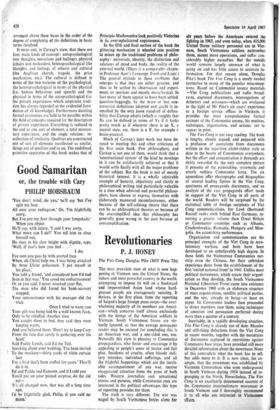Revolutionaries
P. J. HONEY
The Viet Cong Douglas Pike (MIT Press 72s) The most prevalent view of what is now hap- pening in Vietnam sees the United States, the richest and most powerful country in the world, attempting to impose its will on a backward and impoverished Asian land whose hard- pressed people are courageously resisting. It derives, in the first place, from the reporting of Saigon's large foreign press corps—the over- whelming majority of its members are Ameri- can—which concerns itself almost exclusively with the doings of the American soldiers in Vietnam. South Vietnamese forces are vir- tually ignored, so that the average newspaper reader may be excused for concluding this is an American war, and a one-sided one, too. Naturally this view is pleasing to Communist propagandists, who foster and encourage it by appealing to people's sense of justice and fair play. Incidents of cruelty, often bloody mili- tary mistakes, individual sufferings, and all the frightful happenings which are the inevit- able accompaniment of any war, receive exaggerated attention from the press of both sides. Western journalists seek sensational stories and pictures, while Communist ones are interested in the political advantages this type of reporting provides for them.
The truth is very different. The war was
waged by South Vietnamese forces alone for six years before the Americans entered the fighting in 1965, and even today, when 415,000 United States military personnel are in Viet- nam, South Vietnamese soldiers outnumber them, mount more operations, and suffer con- siderably higher casualties. But the outside world remains largely unaware of what is going on and has little access to accurate in- formation. For that reason alone, Douglas Pike's book The Viet Cong is a sorely needed corrective to many of the popular misconcep- tions Based on Communist source materials —Viet Cong publications and radio broad- casts, captured documents, interrogations of defectors and prisoners—which are evaluated in the light of Mr Pike's six years' experience as a foreign service officer in Vietnam, it provides the most comprehensive factual account of the Communist enemy, his motives, techniques, organisation. and actions. yet to appear in print.
The Viet Cong is not easy reading. The book is lengthy, closely argued, and peppered with a profusion of quotations from documents written in the repetitive cliché-ridden style so dear to the hearts of Communists everywhere, but the effort and concentration it demands are richly rewarded by the very complete picture it presents of the painstaking, systematic and utterly ruthless Communist force. The six appendices offer photographs and biographies of several leading figures in the Viet Cong, specimens of propaganda documents, and an analysis of the vast propaganda effort made in support of the Viet Cong in all parts of the world. Readers will be surprised by the statistical table of foreign recipients of Viet Cong communications, for Lord (Bertrand) Russell ranks sixth behind East Germany, re- ceiving a greater volume than Great Britain or Communist countries such as Albania, Czechoslovakia. Rumania, Hungary and Mon- golia. An astonishing performance.
Organisation and communication are the principal strengths of the Viet Cong in revo- lutionary warfare, and both have been developed to an unbelievably high degree. In these fields the Vietnamese Communists out- strip even the Chinese, for their unbroken experience dates from the establishment of the first 'united national front' in 1941. Unlike most political movements, which create their organi- sation as they develop, the South Vietnamese National Liberation Front came into existence in December 1960 with an elaborate structure of mass organisations, satellite political parties, and the rest, already in being—at least on paper. Its Communist leaders then proceeded to direct members into them, using techniques of coercion and persuasion perfected during more than a quarter of a century.
Inevitably, in a rapidly developing situation, The Viet Cong is already out of date. Massive and still-rising defections from the Viet Cong in recent months, together with the mountains of documents captured in operations against Communist base areas, have provided still more detailed information about the movement. None of this contradicts what the book has to tell, but adds more to it. It is now clear, for ex- ample, that the movement was established by Vietminh Communists who went underground in South Vietnam during 1954 instead of re- grouping to the North. Nevertheless, The Vies Cong is an excellently documented account of the Communist insurrectionary movement in South Vietnam and I thoroughly recommend it to all who are interested in Vietnamese affairs.






























 Previous page
Previous page